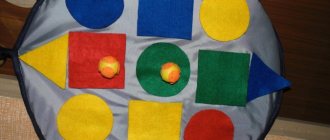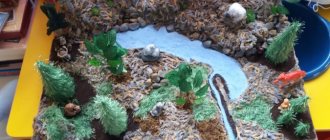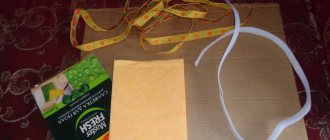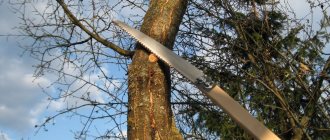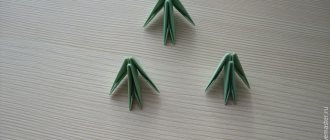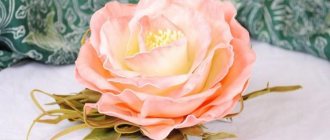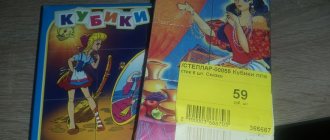Master class “Spikelet”
Olga Konovalova
Master class “Spikelet” I would like to present to your attention my work on making
spikelets for matinees and evening entertainment. We used them at the autumn matinee “Bread Land”, dance with ears of corn . To make one spikelet you will need : a shelf for balloons, yellow corrugated paper, santipon, pencil glue (13 grains: 1 for the top and three for each row; there should be 4 rows)
.
cut a thin strip of corrugated paper, coat it with glue and wrap it diagonally around the stick. Prepare the “grains” for the spikelet . Cut into rectangles (6x12, roll into balls from santipon and wrap like candy. Twist one side - this will serve as a spine.
You can collect the spikelet . We screw one “grain” onto the very top, having previously smeared the lower part with glue.
Then we glue 3 “grains” in each row.
The side of the “grain” that is closer to the stick is also glued with glue and pressed. This is so that the “grain” does not stick out to the sides later (it doesn’t look nice)
.
For the long ears we used cut chacon branches. Try it too. Good luck.
DIY foam masks Good evening. Dear colleagues! I want to share with you my new hobby. One day I came across an interesting book “Making.” Heart for Valentine's Day. You will need: - corrugated paper (green and yellow); - corrugated cardboard; - velvet paper; - glue; - pencil; - ruler;.
Source
How to make a wreath from natural materials and meadow herbs
Before making a wreath from natural material and meadow grasses, you need to prepare all the tools and materials:
- cardboard base made of corrugated cardboard;
- various dried meadow herbs;
- sisal;
- plaid material;
- tape;
- glue gun
Progress
- Cut out 2 circles from cardboard and glue them together. Cut a strip of fabric and wrap it around the base, securing the tip of the fabric with glue.
- Trim the herbs, leaving the stem length approximately 1-2 cm. Form small bunches, secure each bunch with tape.
- Heat up the glue gun and start gluing the bunches in a circle in this order: first glue the longest ones, then the shorter ones and the shortest ones. Each subsequent bunch should slightly cover the previous one. In this way, you can disguise the places where the grass sticks to the base.
- Use green sisal fiber to decorate the base. Sisal is also glued with hot glue.
- Tear off a few fibers of sisal and twist them to form a rope. The rope should be quite strong, as it will be used as a hanger for the wreath.
- Attach the pendant to the wreath.
Master class “Spikelet” (origami)
Larisa Mikhailova
Master class “Spikelet” (origami)
Autumn has come again. Brought trouble to harvest.
I bring to your attention a master class on making “ Spikelet ” ( origami )
.
For work we will need: yellow colored paper; yellow double-sided cardboard; pencil; ruler; scissors; glue.
We mark a sheet of yellow paper into squares, I took squares measuring 6x6 cm. Choose the dimensions depending on the size of the finished product (the larger the square, the larger the size of the finished spikelet ).
Cut into squares.
Let's start folding the spikelet :
1. From a square, make a basic triangle
.
2. Fold it in half.
4. Bend the sides towards the resulting midline.
5. Turn the workpiece over.
6. Bend the upper sharp corners towards you, forming two right angles at the top.
Wreath “Herbs of Provence”
Materials:
- wreath made of vines;
- 3 artificial lavender sprigs;
- fishing line;
- glue gun;
- ribbon.
Progress
- Disassemble the branches into small inflorescences; if necessary, use wire cutters to cut through the wire.
- Using a heated glue gun, glue the branches to the base, moving in a circle. Do not apply too much glue to the branches, otherwise the work will look sloppy.
- Tie a matching ribbon to the wreath.
Adviсe:
- If you want to get a thicker and more magnificent wreath, use 5-6 artificial branches.
- The branches can be attached using thin colored bead wire. It comes in different colors, so it won’t be difficult to choose the right color.
- A wreath can be made using natural lavender sprigs. You can weave a wreath using live twigs and dry the lavender in the wreath, or you can make a wreath from already dried lavender flowers.
- By applying a drop of lavender essential oil to artificial sprigs, you will also be infused with the subtle aroma of blooming lavender.
- Such a wreath can be made for an interior in the Provence style, which is associated with the bright summer sun, the sea and huge fields of blooming lavender. Provence is a southern region of France. The word “Provence” itself translates as “province,” and interiors created in this style correspond to the style of provincial houses in the south of France.
Corrugated paper spikelet
Hello everybody! Today I come to you with a new idea))) I looked in our Country for how to make spikelets and couldn’t find anything similar to mine. Maybe you will like my master class and try to do the same with me.
You can get any color of the spikelet, depending on the color of your corrugated paper. Can be yellow or gold. Or you can make a green spikelet that is not yet ripe.
I used a spikelet to decorate a postcard with bears in a haystack) you can make a lot of spikelets and add them to a bouquet of flowers.
We will need: glue, scissors, pearl barley, corrugated paper.
Cut a strip of paper. Draw a leaf about 2 by 7 cm and cut it out.
Now we wrap the grain in paper.
We do it carefully and not hastily.
They twisted the grain. Then we twist the ends.
The thinner tip will be a tendril; it can be twisted a little and made wavy. The thicker tip will be the stem.
We do the next one in exactly the same way.
Let's start gluing. We take three grains and connect them with a drop of glue. We wait a bit until it dries.
Just below we glue four grains. Be very careful not to damage the paper. It quickly gets wet from the glue.
We make another row of four grains. Next we will thin the leg.
We move the last glued grains-tips apart, cut off the previous ones.
Ask questions if it is not clear.
I made the last row from five grains. I smeared the leg with glue, twisted it and dried it. You can make more rows and the spikelet will be longer. It took me about 20 minutes to do everything.
We straighten the tendrils of the spikelet and admire the result)))
And this is a new version of the spikelet, a pigtail. Thanks for the idea GrekaRek! My work with new spikelets https://stranamasterov.ru/node/789944 can be viewed here.
Well, you have learned how to make spikelets with your own hands. Try, create, create! You will definitely succeed)))
Thank you for your attention!
Regards, Anna.
Did you like the article? Subscribe to the channel to stay up to date with the most interesting materials
Source
Didukh - ancient Slavic tribal New Year symbol
Didukh is the oldest Slavic, Dulib, Russian, Ukrainian, New Year, Christmas symbol, a sign of the immortality of ancestors, a talisman of the family, prosperity, prosperity, a good harvest. He is the Slavic grandfather's Spirit, the Spirit of the ancestors of the clan, a sign of the presence of ancestors at New Year's celebrations (at the birth of a new stake).
For all Slavs, the first and last sheaf of the harvest had and still has a special meaning. Didukh is the name given to everything that the owner and his eldest son are the first to bring into the house on Christmas Eve - a sheaf of rye, wheat or oatmeal, which the owner places in the red corner, around which the eldest son or owner spreads straw and hay on the floor and on the table under the tablecloth.
Didukhi in the traditional folk palette of the Christmas cycle of holidays can differ in local flavor, have their own typological features, which is due to the influence of local and Christian traditions, shifts in the calendar, loss of the internal form of customs and rituals, changes in the traditional way of life.
Didukha was made from the first harvested or last harvested sheaf. On the eve of the holidays, several bundles were formed from the stems of the ritual sheaf, each of which was separately braided with straws or tied with colored threads. Then such bud segments were collected together and wrapped with ribbons, forming a lush sheaf. Branches like legs were made at the bottom so that the didukh could stand. Bunches of ears of corn were framed on top with colored ribbons, paper or dried wildflowers.
Didukh was brought into the house on Christmas Eve. An unthreshed sheaf of wheat or rye, specially preserved from the time of the harvest, was solemnly brought into the house after going around the yard.
The Slavs called this festive sheaf “Old Man”, “Didukh”, “Kolyada”, “Kolyadnik”. He performed his ritual role throughout the Christmas holidays. He stayed in the house until the New Year or Epiphany.
In the Central Slavic Volyn-Carpathian region (the center of the Dulib state), in Pokuttya, Hutsul and Boykivshchyna, Didukh symbolizes the ancestor of the family - the grandfather, as well as all the Ancestors who once lived in ancient times.
It is during Didukh’s stay in the house that all the souls of relatives must come together to have dinner together. Therefore, on Rich Kutya for the dead, spoons were placed near Didukh, where the souls of ancestors seemed to be located, and at night they placed kolivo (a dish made from honey and seasoned with kutya) nearby. This was to continue as long as the sheaf was in the house.
The festive sheaf was in the house for a week (sometimes even until Epiphany). His presence brought a festive mood, comfort and festivity to the family. People used to say “Didukh in the house - trouble from the hut” (in the language of the ancient Russians and Ukrainians: “Didukh before the house - trouble from the house”).
Nowadays, a sheaf often replaces a small bouquet of ears of grain, various dry herbs and immortelle flowers.
In recent decades, more and more Ukrainians are restoring the tradition of placing a truly Slavic ancestral sign in their homes on New Year and Christmas - Didukha.
Didukh, hay, and Christmas traditions have a positive charge of energy and give us a feeling of belonging to the ancient Slavic sacraments.
It has been a long-standing tradition to place multi-meter Didukhs during the Christmas holidays on the avenue in the central squares in Kyiv, Lviv, Ternopil, Rivne, Ivano-Frankivka and other cities.
Today the whole country is perceived as a common home, and Didukhi are the souls of the Ancestors, with whom you need to establish contact and ask for help.
Currently, ancient traditions are not particularly revered, but it is interesting to learn about them, and in some places revivals of ancient, forgotten traditions have begun. So, for example, in Lvov for many years in a row they have been weaving a didukha 3 meters high and taking it out into the street, accompanying the cheerful procession with songs and dances. The central streets of other cities are now decorated with didukh and placed at fairs; this gives an unusual folk flavor. You can weave a didukh yourself by preparing ears of wheat, rye, and oats from the summer. It is easier to weave when the ears are slightly dry, but not completely dry. It is important to weave with good thoughts, with a pure soul, with prayers and strictly adhere to the pattern - first the head, then 12 bundles, and in a bundle there are 7 ears of ears, you can decorate as you please.
The ancient Slavic custom of glorifying the Ancestors, glorifying the Slavic family is alive!
THIS MAY BE INTERESTING MORE FROM THE AUTHOR
Family among the ancient Slavs: a little about tradition
Slavic rituals: how it was and how it is
Naming ceremony
3 COMMENTS
On the eve of the birth of the month, at midnight, the didukh was taken out of the house. It was believed that it was at this time that the good souls of their ancestors left their relatives. The sheaf-paradise was divided into parts. One part was threshed - several grains were given to dear people, the remaining grains were added to the grains intended for sowing, and fruit trees were tied with the resulting straw to ensure a good harvest. Another part was used as a sprinkler for holy water, after adding cornflowers, basil and fir branches. Also, part of the didukh was left until next year. And finally, the last part was burned while singing and dancing.
Didukh has several names: didochok, dido, sheaf-paradise, caroler, kolyada, paradise-didukh. Large and sunny, decorated with ribbons, a sheaf of dried flowers of rye, wheat, oats or flax. As a manufacturing scheme, take an icon that depicts the Last Supper of Jesus Christ with the 12 apostles; the didukh should have a “head” at the top and 12 branches on the sides. The number of ears of grain in each bunch (branch) must be a multiple of seven, since the didukh symbolizes the seven tribes of the clan.
Didukh is traditionally a small sheaf of wheat, which is beautifully and tightly tied with wheat stalks and beautifully decorated. But didukh is also made not only from wheat, but also from rye, oats or flax, and is decorated with multi-colored ribbons and beads. Didukh is a Christmas amulet for the family. Previously, it was the didukh that replaced the New Year tree. Didukh is also called sheaf-paradise, didochok, paradise-didukh. A didukh is a very, very ancient object that was made with one’s own hands from wheat grown with one’s own hands, and the didukh was necessarily made from the first or last sheaf of wheat. Didukh takes its roots from pre-Christian times in Ukraine. Didukh was endowed with the image and power of the ancestor of the clan. In those days, the spirits of deceased ancestors were highly respected. Didukh is woven in December, and the sheaf is prepared in the summer. Symbolically, the didukh has a head at the top and strictly 12 branches on the sides. 12 is the number of apostles. They placed the didukh on the Christmas table in a place of honor, and next to it they placed a woman made of straw. Then the didukh was moved to the icons and kept in their house throughout Christmas Eve, and taken out at midnight on the new month. It was at this time, because it was believed that on the new month at midnight the good spirits of the ancestors left the family. Then the didukh was taken apart and one part was tied around the fruit trees so that the harvest would be rich in the coming year. The other part, namely the grains, was left for future sowing. It was customary to give part of the grains to near and dear people. Another part was used to make a sprinkler for blessing with holy water, but they also added some herbs, twigs and flowers. And another part of the paradise sheaf was left for the next didukh, for next year. And everything that remained was simply burned.
Source
